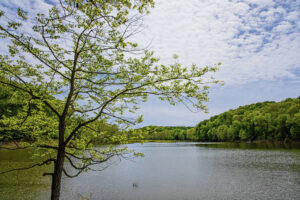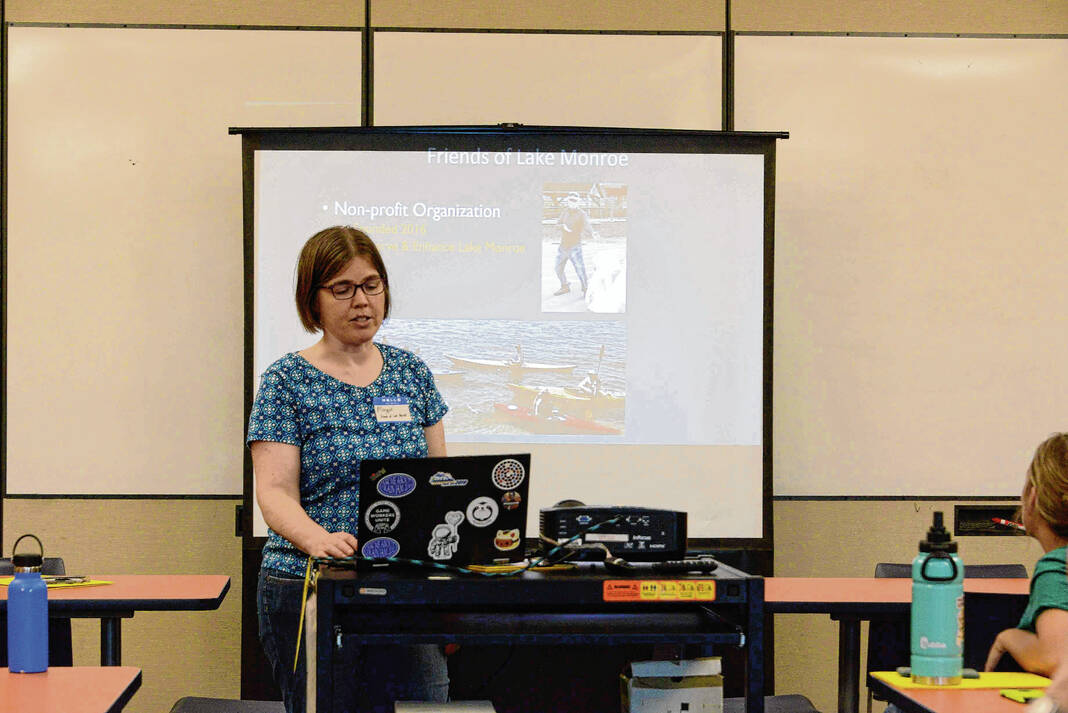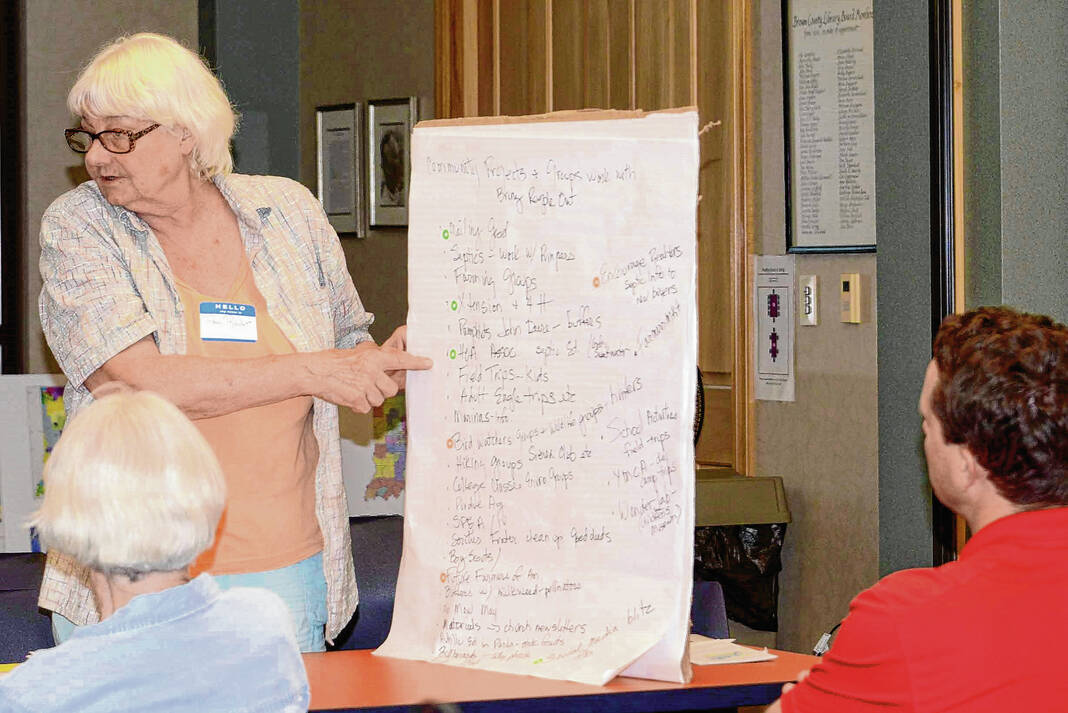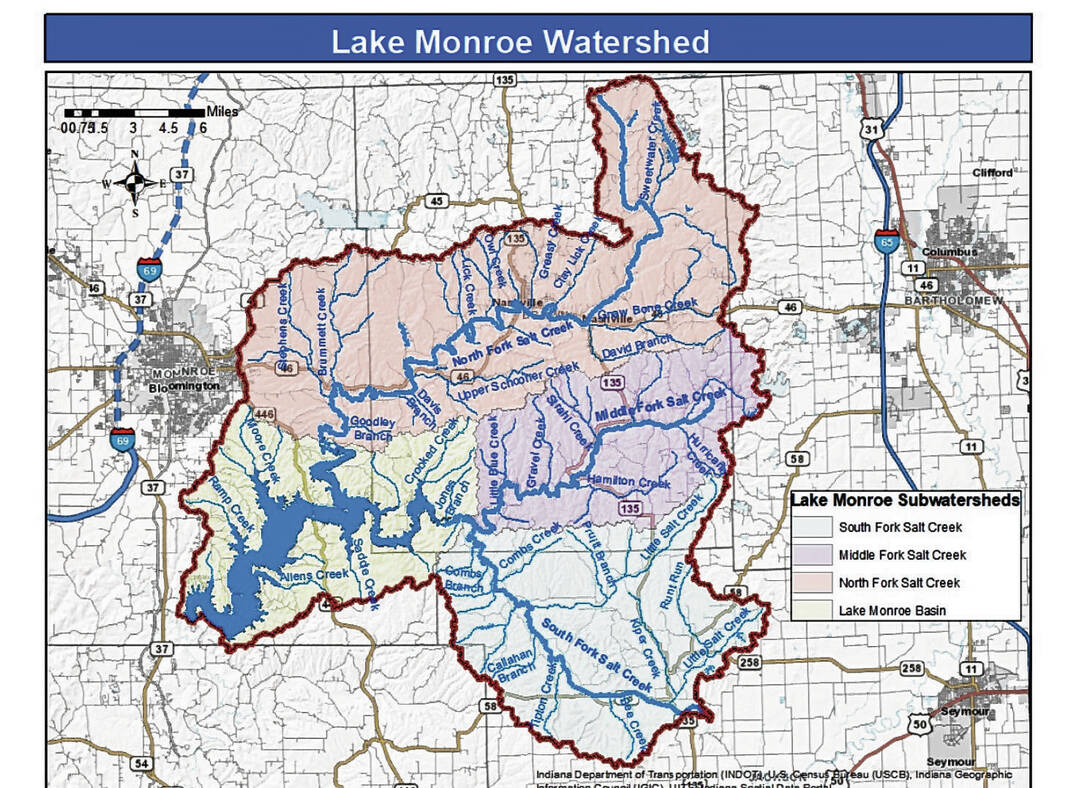Brown County is home to more than half of the land that water flows through in creeks and streams on its way to Lake Monroe.
Lake Monroe’s 10,750 acres of water surface is spread over Monroe and Brown counties. Residents and visitors alike often enjoy boating, fishing and swimming in the lake. At one time parts of Brown County received water from the City of Bloomington Utilities, which gets water from the reservoir.
More than 20 Brown County streams flow into the lake through North Fork Salt Creek and Middle Fork Salt Creek including Greasy Creek, Gnaw Bone Creek, Hamilton Creek, and Sweetwater Creek.
“People in Brown County may not feel that connected to Lake Monroe. It’s hard to get there from here. There are a lot of other great natural resource in Brown County when people are looking for a place to hike or whatnot. But it also impacts the creeks in Brown County,” said Maggie Sullivan, the watershed coordinator for Friends of Lake Monroe.
Sweetwater and Yellowwood lakes along with the lakes in the Brown County State Park are all in the Lake Monroe watershed, which Friends of Lake Monroe is working to protect from sediment and other threats.
For the last couple of years, Friends of Lake Monroe has offered guided kayak tours with a goal to get people on the water who maybe haven’t kayaked before as a way for them to realize the value of the reservoir.
Another way the group is trying to help the lake and its watershed is by offering a septic system maintenance cost share program in Monroe County. A mailer was sent out to 3,000 households with septic systems in the watershed in Monroe County, offering them a voucher to get half off the cost of septic tank pumping.
A septic tank should be pumped every three to five years. Sullivan said they received a positive response to the program in Monroe County.
“A lot of people don’t even realize that’s something they should be doing. Our goal really was to educate, but we also wanted to offer this incentive that if people did it now they can get some money off,” she said.
Now the group is interested in bringing that program to Brown County. A funding source is still being sought to bring the program here. Sullivan said Friends of Lake Monroe want to partner with local groups, such as the Brown County Regional Sewer District, for that program.
Community input

Earlier this summer, 60 people attended three different community forums to discuss the newly published Lake Monroe watershed management plan. The Friends of Lake Monroe and the Leagues of Women Voters of Bloomington-Monroe County and Brown County partnered to host the forums.
The watershed plan was developed by Friends of Lake Monroe. It involved gathering and analyzing data over a two year period on the lake and its watershed — or land that water travels either over or under on its way to a stream, river or lake.
Two goals were set for the forums: sharing the latest updates on the watershed management plan and receiving input from community members on how to better engage them to protect the lake from various issues.
In the summer of 2018, Friends of Lake Monroe applied for a grant to take water samples and develop a management plan for the Lake Monroe watershed. The Brown County Commissioners, along with over 30 other private and public stakeholders, wrote a letter of support for the grant application. In November of 2019, the grant was awarded to the Friends of Lake Monroe.
Over the next two years, water samples throughout the watershed were analyzed for possible pollutants, including E. coli. Volunteers collected water samples from streams across the county. The goal was to understand water quality draining into Lake Monroe through its tributaries.
The watershed management plan summarizes the available data, identifies top threats to water quality and provides an action plan to reduce pollution and improve water quality in the lake and its tributaries over the next 20 years.
The results of the analysis, along with input from residents, business and government, will be incorporated into the plan to reduce pollution in the lake and watershed.
The top issues facing Lake Monroe are sediment, nutrients and bacteria, Sullivan said.
During the forums, discussion also centered on how water sampling showed the lake has an excess of nutrients, which is what stimulates the harmful alga blooms.
“Those have a huge impact not only on recreation, but on drinking water, treatment and they can just really be harmful if they get out of control,” Sullivan said.
“We know there will always be some sediment moving because that’s natural in streams, but we want to try to minimize any of that excess that comes from human activity.”
Sediment gets into waterways when soil is left bare, such as when a home is being built or when a field is left bare after a harvest. Minimal or no till planting is one way to prevent sediment along with using cover crops or covering bare soil with straw or mulch and using silt fences around construction sites.
E.coli has also been identified in waterways, but Sullivan said more testing is required to determine if the majority is coming from animal or human sources.
“From what we see there is definitely both present. We want to address the human source, which is likely failing septic systems, and the animal source, which could be livestock or pets or wildlife,” she said, adding anything that can be done to keep waste from either source out of the water is best.
The groups also wanted ideas on how to spread the word to encourage residents to change habits and behaviors to better protect the watershed. Almost 200 ideas were collected during the forums.
“Finding an ambassador within any community we’re trying to reach whether that’s farmers, boaters or foresters, that if we can find someone already in those groups they can reach out better than we can,” Sullivan said of the ideas shared.
Engaging youth was another idea presented as a way to better educate residents.
“Having the kids educate their parents and doing that through schools, Y, day camps or Scouting groups,” Sullivan said.
Other ideas included sharing information through inserts in utility bills and talking to conservancy groups.
“Just a way to get people hands on, involved and connected,” Sullivan said.
“It empowers people to actually do something instead of just talking about something. People learn a lot more. They remember more with hands-on experiences. I think it’s just more intriguing to actually get and do something, maybe something a little different.”
Read online
The full Lake Monroe Watershed Management Plan and a shorter executive summary are available online at www.friendsoflakemonroe.org/watershed-plan/.









